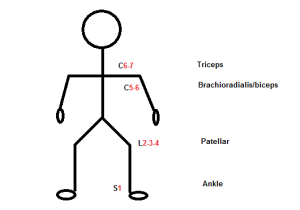The Alvarado score is a popular score used in emergency medicine to determine the likelihood of an appendicitis. This score is a high sensitivity for appenciditis and is therefore best for ruling it out (sensitivity of a score of 5 is 99% and specificity of a score of 7 is 81%). It is unreliable in children and more reliable in men than women. You may refer to a systematic of the Alvarado score below.
The Alvarado score has 8 criteria for a total score of 10 points. Alvarado score may be remembered using the following memory trick: “My Appendix Feels Likely To Rupture Now”.
My = Migration of pain to the right iliac fossa
Appendix = Anorexia
Feels = Fever of 37.3 Celsius or more
L = Leukocytosis
T = Tenderness in the right iliac fossa
R = Rebound tenderness
N = 1) Nausea or vomiting 2) Neutrophilia
**Tenderness in the right lower quadrant and leukocytosis count for 2 points each. All other criteria count for 1 point.
A score of 1 to 4 points has a 30% probability of being appendicitis. No imaging is suggested (note: if score is 4 points and there is clinical suspicion, imaging is suggested). The patient may be discharged.
A score of 5 to 6 points has a 66% probability of being appendicitis. A CT of the abdomen is suggested. The patient should be observed +/- admitted.
A score of 7 to 10 points has a 93% probability of being appendicitis. Consult a surgeon.
Please refer to this article by Ohle et al. entitled “The Alvarado score for predicting acute appendicitis: a systematic review” for more reading. Thanks for reading!
*Note: this tool (and other risk stratification tools posted on this blog) is only for use by medical professionals in the medical context. If you are concerned for your health, please consult your physician!
Follow us to receive weekly posts directly in your inbox! Just enter your email address in the box on the top of the menu on the right and click “Follow”.
Click here to share a mnemonic for a future edition of The Weekly Mnemonic.
